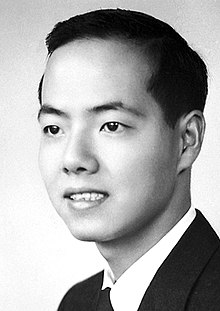
Back تسونج لي Arabic تسونج لى ARZ Tsanq-Dao Li Azerbaijani تسونق-دائو لی AZB Лі Цзундаа Byelorussian Джъндао Ли Bulgarian সুং-দাও লি Bengali/Bangla Tsung-Dao Lee Catalan Li Čeng-tao Czech Tsung-Dao Lee Danish
Tsung-Dao Lee | |||||||||||||||
|---|---|---|---|---|---|---|---|---|---|---|---|---|---|---|---|
李政道 | |||||||||||||||
 Lee in 1956 | |||||||||||||||
| Born | November 24, 1926 | ||||||||||||||
| Died | August 4, 2024 (aged 97) | ||||||||||||||
| Alma mater | |||||||||||||||
| Known for | |||||||||||||||
| Awards | Nobel Prize in Physics (1957)
| ||||||||||||||
| Scientific career | |||||||||||||||
| Fields | Physics | ||||||||||||||
| Institutions | |||||||||||||||
| Thesis | Hydrogen Content and Energy-productive Mechanism of White Dwarfs (1950) | ||||||||||||||
| Doctoral advisor | Enrico Fermi | ||||||||||||||
| Doctoral students | |||||||||||||||
| Chinese name | |||||||||||||||
| Chinese | 李政道 | ||||||||||||||
| |||||||||||||||
| Signature | |||||||||||||||
 | |||||||||||||||
| Modern physics |
|---|
| |
| Quantum field theory |
|---|
 |
| History |
| Standard Model of particle physics |
|---|
 |
| Statistical mechanics |
|---|
 |
Tsung-Dao Lee (Chinese: 李政道; pinyin: Lǐ Zhèngdào; November 24, 1926 – August 4, 2024) was a Chinese-American physicist, known for his work on parity violation, the Lee–Yang theorem, particle physics, relativistic heavy ion (RHIC) physics, nontopological solitons, and soliton stars. He was a university professor emeritus at Columbia University in New York City, where he taught from 1953 until his retirement in 2012.[1]
In 1957, at the age of 30, Lee won the Nobel Prize in Physics with Chen Ning Yang[2] for their work on the violation of the parity law in weak interactions, which Chien-Shiung Wu experimentally proved from 1956 to 1957, with her well known Wu experiment.
Lee remains the youngest Nobel laureate in the science fields after World War II. He is the third-youngest Nobel laureate in sciences in history after William L. Bragg (who won the prize at 25 with his father William H. Bragg in 1915) and Werner Heisenberg (who won in 1932 also at 30). Lee and Yang were the first Chinese laureates. Since he became a naturalized American citizen in 1962, Lee is also the youngest American ever to have won a Nobel Prize.[citation needed]
- ^ Home | Columbia News Archived April 30, 2012, at the Wayback Machine
- ^ "The Nobel Prize in Physics 1957". The Nobel Foundation. Retrieved November 1, 2014.

